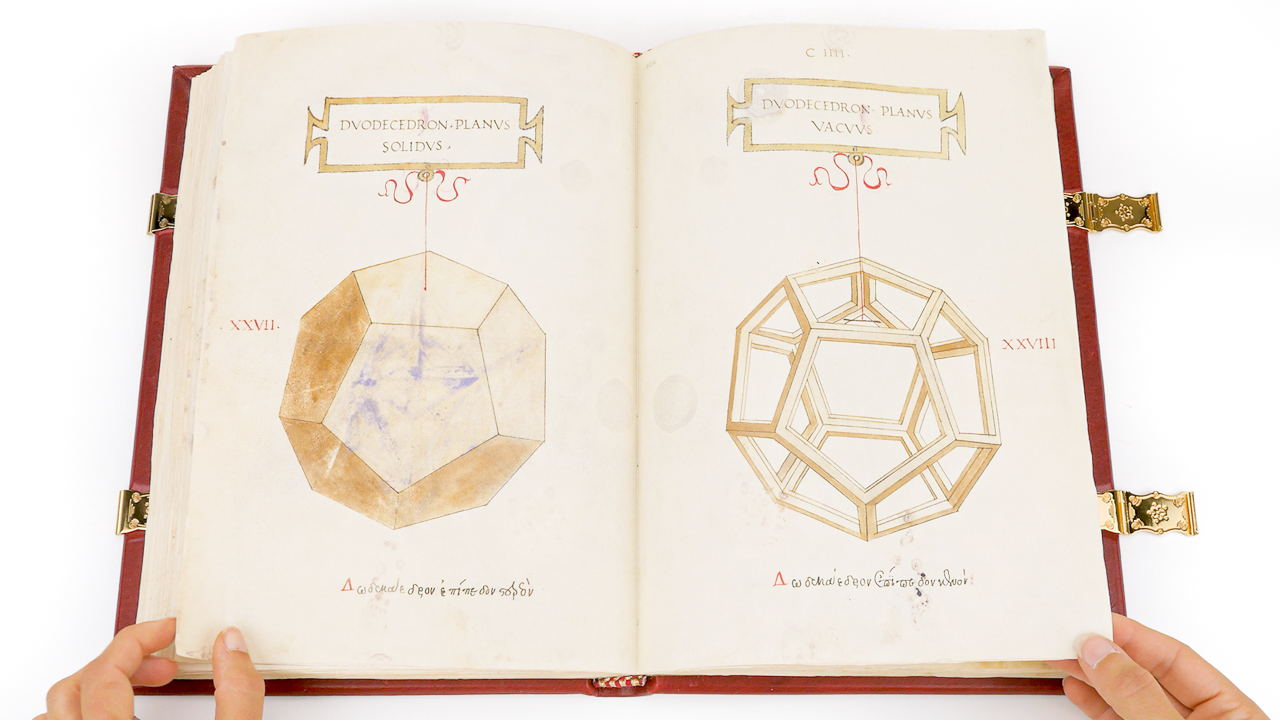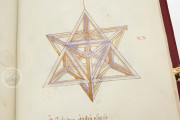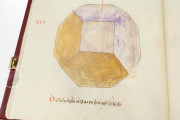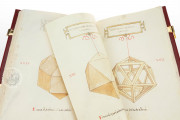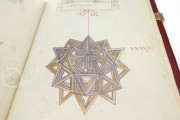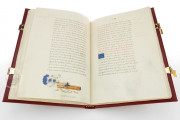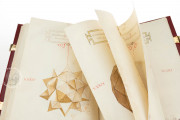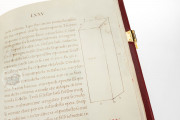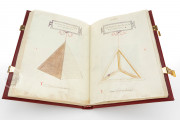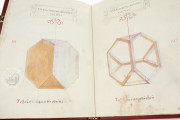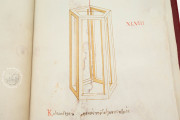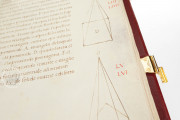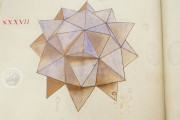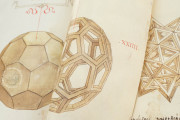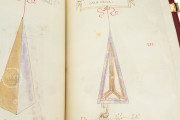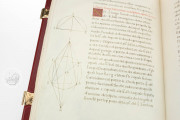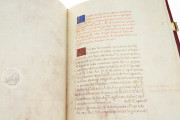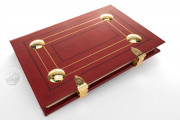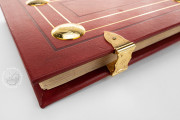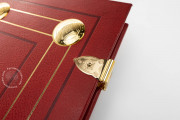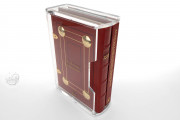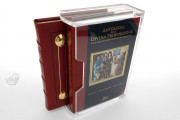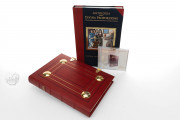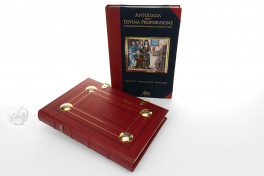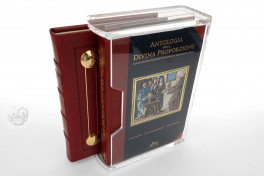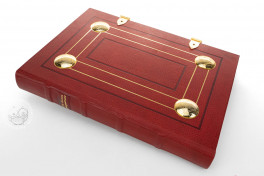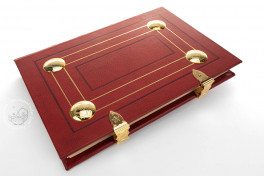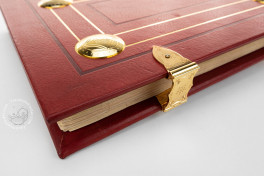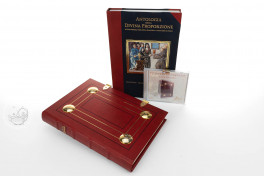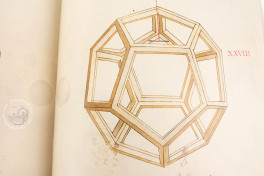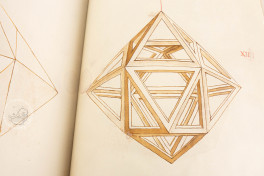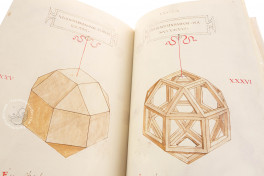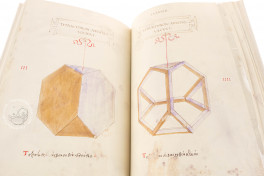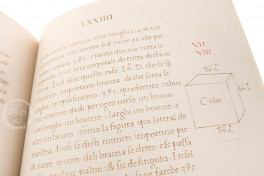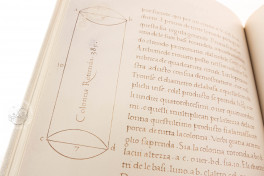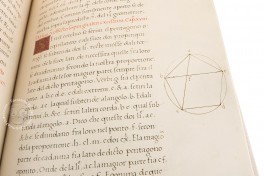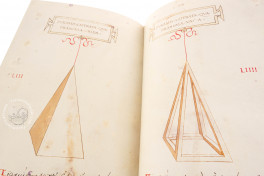The Geneva Compendium on Divine Proportion is a manuscript of De divina proportione by Luca Pacioli. It was copied in Milan in 1498 for Ludovico Sforza, Duke of Milan. A presentation miniature by the Master of the Epithalamium of Giasone dal Maino introduces the book's main text, an Italian-language treatise on the golden section based on the principles of Euclid. There follows a series of sixty full-page drawings of regular polyhedra, each shown in two views, probably following designs by Leonardo da Vinci, accompanied by captions in Latin and Greek.
Luca Pacioli (ca. 1445-1517) emerged as arguably the preeminent mathematician and geometer of his era. In De divina Proportione, Pacioli synthesized contemporary discourse on the divine nature of geometry, presenting it for the first time in vernacular language.
The Illuminated Manuscript: A Gift to Power
The manuscript currently housed in the Bibliothèque de l'Université de Genève was formally presented to Ludovico Sforza, Duke of Milan, in 1498. The presentation page features an illuminated miniature documenting this momentous event. Ludovico Sforza, commonly known as Ludovico il Moro, appears seated alongside four members of his court, extending his hand to receive the book offered by its author. The Sforza coat of arms adorns the lower section of the folio, establishing the ducal provenance of this exceptional work.
For De divina proportione, Leonardo da Vinci created remarkably precise representations of 60 distinct polyhedrons. The crisp elegance of these skeletal geometric figures remains breathtaking to modern viewers. These illustrations represent a watershed moment in the evolution of stereography, as they constitute the first clear visual distinction between the front and back perspectives of three-dimensional solids.
The Scholarly Friar: Pacioli's Life and Influence
Luca Pacioli was a Franciscan friar who traveled extensively as a teacher of mathematics. During his tenure at the court in Urbino, he composed a text explicating double-entry accounting, a contribution that secured him a preeminent position in commercial history. Modern scholarship in business history has appropriately designated him the "father of accounting."
Fra Pacioli's growing reputation led to an invitation to join Ludovico Sforza's court in Milan, where his fateful meeting with Leonardo da Vinci occurred. This intellectual partnership proved mutually beneficial: Pacioli instructed Leonardo in complex geometric principles, while Leonardo enlightened Pacioli about the practical applications of geometry in artistic and architectural contexts.
The Structure and Content of De Divina Proportione
The text of De divina proportione meticulously explored the application of geometric principles to art and architecture, thereby imbuing these creative disciplines with divine significance. Working in Milan in close collaboration with Leonardo da Vinci, Pacioli produced a text that would exert profound influence on both scientific and artistic developments during the age of humanism.
The treatise clearly emerged from the intimate intellectual collaboration between these two Renaissance scholars. In his examination of divine proportion, Pacioli first addressed contemporary theological, philosophical, and musical thought through the mathematical lens of the golden ratio (also known as the golden section or golden mean). He then proceeded to a thorough analysis of Euclid's Elements before exploring regular and dependent polyhedrons.
The latter portion of the manuscript encompasses a treatise on architecture based on Vitruvian principles and an Italian translation of Piero della Francesca's Short Book on the Five Regular Solids (Libellus de quinque corporibus regularibus). This translation facilitated broader dissemination of Piero's significant contributions to perspective and proportionality theory. Piero della Francesca and Pacioli had undoubtedly exchanged mathematical and artistic concepts during their concurrent presence at the Urbino court.
The Enduring Legacy of a Renaissance Masterpiece
The complete text of De divina proportione stands as a comprehensive compendium of theological, theoretical, and practical mathematical knowledge that would resonate profoundly throughout Renaissance art and architecture. In Leonardo da Vinci's subsequent works, geometric analysis reveals his thorough comprehension and integration of Pacioli's concepts regarding the divine properties inherent in the golden ratio.
The manuscript's significance in Pacioli's life and work is evident in the three surviving portraits of this frequently underappreciated humanist. The image in the presentation miniature was preceded by a portrait by his friend Piero della Francesca, who depicted Pacioli as St. Peter Martyr in "The Montefeltro Altarpiece" (c. 1473)—a critical monument in art history.
The importance of De divina proportione was further commemorated in a portrait of its author by Jacopo de Barbari (now in the Museo Capodimonte in Naples). This painting shows Pacioli standing behind a table displaying geometric instruments and a book—quite possibly his De divina proportione in red leather binding. That this portrait serves as a pictorial tribute to his manuscript with Leonardo's illustrations is suggested by the inclusion of a transparent rhombicuboctahedron suspended from the ceiling and an opaque dodecahedron resting atop the bound manuscript.
We have 2 facsimiles of the manuscript "Geneva Compendium on Divine Proportion":
- De Divina Proportione (Special Collections Edition) facsimile edition published by Aboca Museum, 2009
- De Divina Proportione (Circulating Stacks Edition) facsimile edition published by Aboca Museum, 2009

